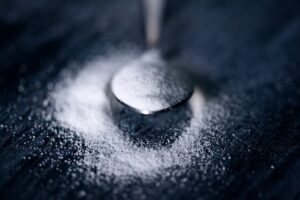THE DEMONISATION OF SUGAR

Fifty years ago, sugar was a good in anybody’s language. Sweetness was equivalent to goodness and Sweetheart was a name we called our closest loved ones. In the 1970s, as a student of food science and technology, I learned how refined sugar (sucrose) was an important preservative, a flavour enhancer in small amounts, and an agent of viscosity and mouthfeel, that was technically difficult to replace. I also learned that grains were largely flavourless, requiring the addition of salt or sugar or both to be palatable. As a PhD student in the field of nutrition, I buried myself in the diets of Australia’s indigenous peoples. I discovered their love of honey made by native bees, who conveniently didn’t sting. Indeed, most hunter-gatherers around the world collected honey on a daily basis and in many cases, it constituted a large proportion of calories [1]. It was even used to sweeten water.
Fast forward 50 years, humans still love calories in liquid form (whether sweet or alcoholic), but we find sugar is commonly described as evil, the devil’s food, a demon, toxic and obesogenic, especially in the form of sugar-sweetened beverages. How did it fall from grace so quickly? Where was the scientific evidence and did it really stack up? In short, no, it didn’t.
Today, we can cite the gold standard findings of systematic reviews and meta-analyses which have concluded that the exchange of added sugars with other carbohydrates (e.g., starches) is not associated with weight benefit [2]. Indeed, recently Te Morenga and colleagues showed that the exchange of ~1 L of sugar-sweetened beverage with the same amount of whole fruit did not alter weight or metabolic outcomes [3]. Of course, like many nutrients at the extremes of high intake (above 20% of total daily energy intake), it can have unwanted effects, particularly on the liver [4].
During the 1990s, Australia was in the midst of a gradual but sustained decline in refined sugar intake, enough to convince the Australian sugar industry to mount a campaign to emphasise that sugar was a natural part of life (sugar cane swirling in the sunlight, grandparents and birthday cakes). Nonetheless, refined sugar intake has continued to decline, with sales of low joule soft drinks and lower sugar varieties now amongst the highest in the world. In 2011 [5] and again in 2017 [6], my colleague Alan Barclay and I collated data that indicated this decline was occurring in the throes of a steep rise in obesity in Australians. We were met with scepticism, and in some cases ad hominin attacks. For some reason we were told that independent FAO/WHO, food industry and government datasets could not be relied upon. But further analyses by the Australian Bureau of Statistics incorporating new datasets and differences between sugar and SSB intake between two national dietary surveys in 1995 and 2011-12 confirmed the downward trend. Still, calls for an additional sugar tax on soft drinks have continued in Australia and around the world. Hypothetical modelling data indicates that many lives would be saved by an increase in tax on sugar-sweetened beverages.
Today, food trends in Australia are relevant to other developed nations around the world. Surveys show that the sources of discretionary calories are changing. As SSB consumption declines, we are eating more cakes and biscuits, chocolate and confectionery. These foods deliver not just refined sugar, but also saturated fat, trans fat, refined starch, and salt, all in an energy-dense form far greater than SSBs, and more likely to be obesogenic and cariogenic than SSBs. Together these foods constitute over ~7% of total energy intake, compared with ~4% from SSBs. Concerningly, people who avoid soft drinks actually consume twice as much energy in the form of alcoholic beverages as those with the highest intake of soft drinks [7]. The fastest way to curb excess liquid calories in Australia would be higher taxes on alcoholic beverages. Falls in domestic violence, car accidents and foetal alcohol syndrome may be desirable ‘side-effects’.
Unintended consequences of a singular focus on sugar in food policy are rarely considered. This includes greater use of low joule, non-absorbable and low-digestibility sugars and alternative sweeteners that may cause gastrointestinal discomfort even in moderate amounts (30 g or more) [8]. Changes in the microbiome are possibly caused by some, but there is much we do not know. Surprisingly, there is little research on differences in diet quality of low vs high sugar consumers. In Australia, there are only trivial differences in the micronutrient density of diets varying from 5% to 15% of energy as free sugars [9]. If energy from added sugars is replaced by refined starch, then there is no energy saving and no weight loss advantage, but a rise in glucose equivalents. Modern starchy foods have a higher glycemic load than the majority of foods containing added sugars, and a high dietary glycemic load is linked to higher risk of type 2 diabetes and cardiovascular disease [10].
The continuing focus on sugar smacks not only of “mono-nutrient fixation” but also distracts public and political attention away from potentially more effective interventions (e.g., higher taxes on confectionery and alcoholic beverages). If desirable changes in food quality are to be realised, a coordinated approach to lowering intakes of all discretionary foods and beverages is needed to balance nutrient intake with nutrient needs. Maintaining a healthy body weight throughout life should be taught as a life skill in young adults, with emphasis on physical activity, reduced sedentariness, as well as high quality diets.
Above all, nutrition guidelines must be evidence-based, not a popular movement with a list of demonised foods. Nutrition is a science, not a religion. Large-scale public health experiments must not be based on questionable evidence. There is a rightful, instinctual place for sweetness on a regular basis, particularly in the context of an otherwise healthy diet. Sweetness, sugars and the human brain have an important role to play in making healthy diets both acceptable and palatable.
Read More:
- Marlowe, F.W. and colleagues. Honey, hadza, hunter-gatherers, and human evolution. Journal of Human Evolution 2014.
- Te Morenga, L. and colleagues. Dietary sugars and body weight: Systematic review and meta-analyses of randomised controlled trials and cohort studies. BMJ 2013.
- Te Morenga, L and colleagues l. No Effect of Added Sugars in Soft Drink Compared With Sugars in Fruit on Cardiometabolic Risk Factors. Front Nutr. 2021.
- Ludwig, D.S. and colleagues. Dietary carbohydrates: Role of quality and quantity in chronic disease. BMJ 2018.
- Barclay, A.; Brand-Miller, J. The Australian paradox: A substantial decline in sugars intake over the same timeframe that overweight and obesity have increased. Nutrients 2011.
- Brand-Miller, J.C.; Barclay, A.W. Declining consumption of added sugars and sugar-sweetened beverages in Australia: A challenge for obesity prevention. The American Journal of Clinical Nutrition 2017.
- Wong, T.H.T. and colleagues. Is there a soft drink vs. Alcohol seesaw? A cross-sectional analysis of dietary data in the australian health survey 2011–12. European Journal of Nutrition 2020.
- Elia, M. and colleagues. Physiological aspects of energy metabolism and gastrointestinal effects of carbohydrates. European Journal Of Clinical Nutrition 2007.
- Mok, A. and colleagues. Intake of free sugars and micronutrient dilution in Australian adults. Am J Clin Nutr 2018.
- Livesey G, and colleagues. Dietary Glycemic Index and Load and the Risk of Type 2 Diabetes: Assessment of Causal Relations. Nutrients. 2019
Professor Jennie Brand-Miller holds a Personal Chair in Human Nutrition in the Charles Perkins Centre and the School of Life and Environmental Sciences, at the University of Sydney. She is recognised around the world for her work on carbohydrates and the glycemic index (or GI) of foods, with over 300 scientific publications. Her books about the glycemic index have been bestsellers and made the GI a household word.








